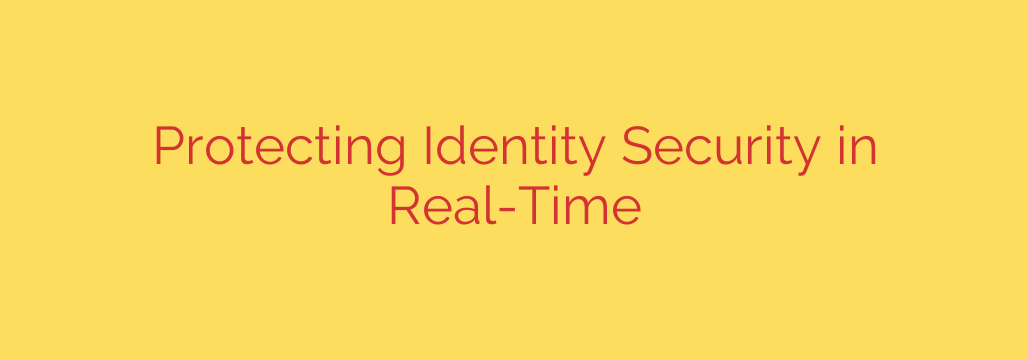
Beyond the Firewall: Securing Digital Identities in Real Time
In today’s hyper-connected world, the traditional concept of a secure corporate perimeter has all but vanished. With data stored in the cloud, employees working from anywhere, and countless applications connecting to your network, the old model of a castle-and-moat defense is no longer effective. The new battleground for cybersecurity isn’t the network edge—it’s identity.
Every user account, from a standard employee to a high-level administrator, is a potential gateway for attackers. A single compromised credential can lead to a catastrophic data breach. This is why securing digital identities is paramount, and doing it in real-time is the only way to stay ahead of sophisticated threats.
The Problem with Yesterday’s Security
Traditional security measures often operate on a delay. A security team might review access logs weekly or run a permissions audit quarterly. While these practices are still valuable, they are fundamentally reactive. A skilled attacker can compromise an account and exfiltrate sensitive data in a matter of minutes, long before a manual review would ever spot the intrusion.
The speed of modern cyberattacks demands a security posture that is just as fast. Waiting for an alert from a periodic scan is like learning about a fire after the building has already burned down. Real-time identity security shifts the focus from post-breach analysis to immediate threat detection and automated prevention.
What is Real-Time Identity Security?
Real-time identity security is a dynamic, always-on approach to protecting user accounts and access privileges. It goes beyond static passwords and permissions by continuously monitoring activity to identify and neutralize threats as they happen.
The core components of this modern approach include:
- Continuous Monitoring: Every login, access request, and permission change is monitored as it occurs. This provides a constant stream of data that can be analyzed for suspicious patterns.
- Behavioral Analytics: Advanced systems establish a baseline of normal behavior for each user. What time do they usually log in? What resources do they typically access? Where do they connect from? Any deviation from this established baseline—such as an impossible login from two countries at once or a sudden attempt to access highly sensitive files—is immediately flagged as a potential threat.
- Automated Response: This is the most critical element. When a high-risk event is detected, the system doesn’t just send an alert; it takes immediate, automated action. This could include forcing the user to re-authenticate with multi-factor authentication (MFA), temporarily locking the account, or revoking access to the targeted resource. This speed of response is what turns a potential breach into a prevented incident.
The Pillars of a Modern Identity Defense
Building a robust, real-time identity security framework requires a multi-layered strategy. Simply installing one tool is not enough. Instead, organizations should focus on integrating several key principles.
1. Embrace a Zero Trust Mindset
The foundational principle of modern security is “never trust, always verify.” A Zero Trust architecture assumes that no user or device is inherently trustworthy, whether they are inside or outside the network. Every single request for access must be verified before it is granted. This eliminates the dangerous concept of a “trusted” internal network and ensures that even if one account is compromised, the attacker’s movement is severely limited.
2. Strengthen Your Authentication Foundation
Before you can monitor behavior, you must be confident that your users are who they say they are. This starts with strong authentication practices.
- Enforce Multi-Factor Authentication (MFA): This is the single most effective step you can take to secure user accounts. By requiring a second form of verification, you make stolen passwords significantly less useful to attackers.
- Eliminate Weak and Reused Passwords: Implement strong password policies and utilize tools that check for compromised credentials.
3. Implement Privileged Access Management (PAM)
Not all accounts are created equal. Administrator and service accounts hold the “keys to the kingdom” and are a primary target for attackers. Privileged Access Management (PAM) solutions are designed to secure, manage, and monitor these powerful accounts. By strictly controlling and auditing all privileged activity in real-time, you can shut down one of the most dangerous attack vectors.
4. Invest in Identity Threat Detection and Response (ITDR)
ITDR is the technology that powers real-time identity security. These specialized tools are designed to analyze identity and access data from across your entire environment—from on-premise servers to cloud applications. They use behavioral analytics and machine learning to detect threats like account takeovers, insider threats, and lateral movement, triggering automated responses to contain the threat instantly.
Actionable Steps to Protect Your Organization
Shifting to a real-time identity security model is a critical step in modernizing your defenses. Here are a few actionable steps you can take today:
- Mandate MFA Everywhere: Prioritize rolling out MFA across all critical applications, especially for email, VPNs, and administrative accounts.
- Audit and Reduce Privileges: Conduct a thorough review of all user permissions. Apply the Principle of Least Privilege, ensuring that every user only has the absolute minimum access required to do their job.
- Educate Your Team: Your employees are your first line of defense. Train them to recognize phishing attempts, use strong passwords, and report suspicious activity immediately.
- Map Your Identity Infrastructure: Understand where all your user identities are stored and managed. Consolidating identities into a central system can dramatically simplify monitoring and protection.
In the end, protecting your organization is no longer about building higher walls. It’s about having perfect visibility and control over who is accessing your data and why, at every moment. By adopting a proactive, real-time approach to identity security, you can move from a position of reaction to one of prevention, effectively neutralizing threats before they can cause harm.
Source: https://www.helpnetsecurity.com/2025/10/06/ebook-defending-identity-security/








